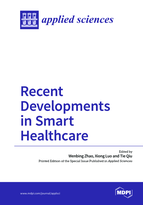Smart Healthcare
A special issue of Applied Sciences (ISSN 2076-3417). This special issue belongs to the section "Computing and Artificial Intelligence".
Deadline for manuscript submissions: closed (15 July 2017) | Viewed by 145461
Special Issue Editors
Interests: fault-tolerant computing; computer and network security; peer-to-peer and grid computing; performance evaluation of distributed systems
Special Issues, Collections and Topics in MDPI journals
Interests: machine learning; optimization; complex system; intelligent processing
Special Issues, Collections and Topics in MDPI journals
Interests: internet of things; big data; wireless sensor networks
Special Issues, Collections and Topics in MDPI journals
Special Issue Information
Dear Colleagues,
Medicine is undergoing a sector-wide transformation thanks to the advances in computing and networking technologies. Healthcare is changing from reactive and hospital-centered to preventive and personalized, from disease focused to well-being centered. In essence, the healthcare systems, as well as fundamental medicine research, are becoming smarter. We anticipate significant improvements in areas ranging from molecular genomics and proteomics to decision support for healthcare professional through big data analytics, to support behavior changes through technology-enabled self-management, and social and motivational support. Furthermore, with smart technologies, healthcare delivery could also be made more efficient, higher quality, and lower cost. In this Special Issue, we welcome original research, as well as review articles in all areas of smart healthcare.
Dr. Wenbing Zhao
Dr. Xiong Luo
Dr. Tie Qiu
Guest Editors
Manuscript Submission Information
Manuscripts should be submitted online at www.mdpi.com by registering and logging in to this website. Once you are registered, click here to go to the submission form. Manuscripts can be submitted until the deadline. All submissions that pass pre-check are peer-reviewed. Accepted papers will be published continuously in the journal (as soon as accepted) and will be listed together on the special issue website. Research articles, review articles as well as short communications are invited. For planned papers, a title and short abstract (about 100 words) can be sent to the Editorial Office for announcement on this website.
Submitted manuscripts should not have been published previously, nor be under consideration for publication elsewhere (except conference proceedings papers). All manuscripts are thoroughly refereed through a single-blind peer-review process. A guide for authors and other relevant information for submission of manuscripts is available on the Instructions for Authors page. Applied Sciences is an international peer-reviewed open access semimonthly journal published by MDPI.
Please visit the Instructions for Authors page before submitting a manuscript. The Article Processing Charge (APC) for publication in this open access journal is 2400 CHF (Swiss Francs). Submitted papers should be well formatted and use good English. Authors may use MDPI's English editing service prior to publication or during author revisions.








